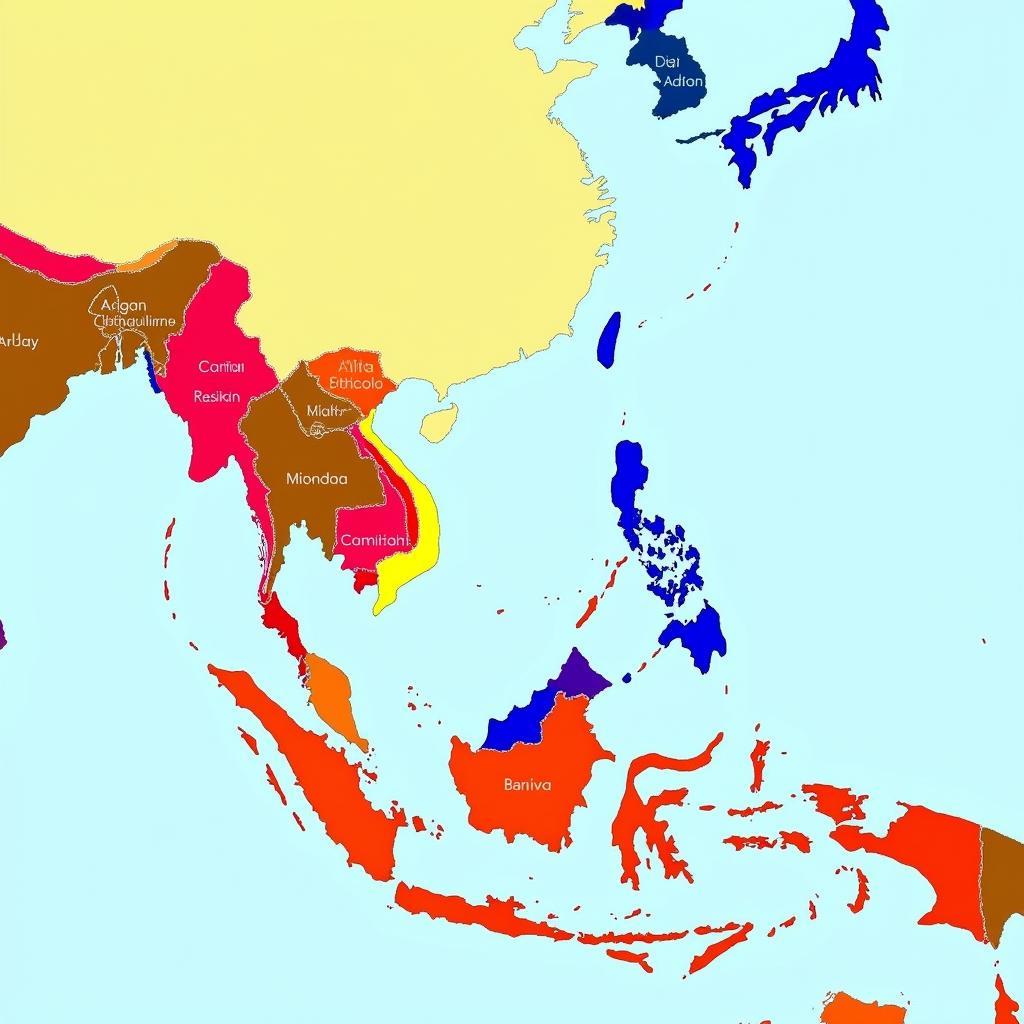The Association of Southeast Asian Nations (ASEAN) is a dynamic intergovernmental organization comprising ten diverse Southeast Asian countries. This article delves into the Asean Country Members, exploring their individual characteristics, collective strengths, and the significant role they play in the global landscape. asean members
Unveiling the ASEAN Country Members
ASEAN, established on August 8, 1967, with the signing of the Bangkok Declaration, represents a remarkable tapestry of cultures, economies, and political systems. The asean country members are: Brunei, Cambodia, Indonesia, Laos, Malaysia, Myanmar, the Philippines, Singapore, Thailand, and Vietnam. These nations, bound by a shared vision of peace and prosperity, collaborate across various sectors, fostering regional integration and driving sustainable development.
 Map of ASEAN Country Members
Map of ASEAN Country Members
Economic Powerhouse: The Combined Strength of ASEAN Nations
Collectively, the ASEAN country members represent a formidable economic force. With a combined GDP exceeding US$3 trillion, ASEAN is a key player in international trade and investment. The region’s strategic location, abundant natural resources, and young, dynamic workforce make it an attractive destination for businesses worldwide. Intra-ASEAN trade and investment play a vital role in promoting regional economic integration and fostering mutual growth. anggota asean saat ini
Cultural Mosaic: A Celebration of Diversity
Beyond economic prowess, ASEAN is a vibrant hub of cultural diversity. Each asean nations members boasts a unique heritage, shaped by centuries of tradition, history, and influences from various civilizations. From ancient temples and bustling markets to vibrant festivals and captivating art forms, ASEAN offers a rich and immersive cultural experience. This diversity is celebrated as a source of strength, fostering mutual understanding and respect among the member states.
Which Countries are Members of ASEAN?
The ten ASEAN member countries are Brunei, Cambodia, Indonesia, Laos, Malaysia, Myanmar, the Philippines, Singapore, Thailand, and Vietnam.
What are the Benefits of ASEAN Membership?
ASEAN membership provides numerous benefits, including enhanced economic cooperation, increased trade and investment opportunities, and strengthened regional security.
How does ASEAN promote regional cooperation?
ASEAN fosters regional cooperation through various mechanisms, including summits, ministerial meetings, and specialized agencies, facilitating dialogue and collaboration on a wide range of issues. ase acount
“ASEAN’s strength lies in its unity in diversity,” shares Dr. Anisa Hassan, a prominent Southeast Asian economist. “The individual strengths of each member nation contribute to the collective power of the bloc, creating a synergistic effect that benefits all.”
ASEAN’s Role in the Global Arena
ASEAN plays an increasingly important role in the global arena. The bloc actively engages with other regional and international organizations, advocating for multilateralism and promoting peace and stability. ASEAN’s commitment to dialogue and diplomacy has earned it recognition as a respected voice in international affairs.
“The ASEAN region is a melting pot of cultures, a dynamic economic powerhouse, and a crucial player on the world stage,” adds Mr. Lee Wei Ming, a renowned cultural anthropologist. “Its vibrant diversity, coupled with its strategic location and growing economic influence, makes it a region of immense potential.”
Conclusion
The ASEAN country members represent a powerful and dynamic force in the global landscape. Through cooperation and collaboration, these ten nations are working together to build a brighter future for Southeast Asia and the world. The asean 10 country name represent a diverse and dynamic group, working towards regional prosperity and international cooperation.
FAQ
- How many countries are in ASEAN? (10)
- When was ASEAN established? (1967)
- What is the purpose of ASEAN? (To promote regional cooperation and integration)
- What are the key benefits of ASEAN membership? (Economic cooperation, increased trade, regional security)
- How does ASEAN contribute to global affairs? (Advocates for multilateralism, promotes peace and stability)
- What are some of the challenges facing ASEAN? (Economic disparities, political tensions, environmental issues)
- How can I learn more about ASEAN? (Visit the official ASEAN website or reputable news sources.)
Scenarios:
- Scenario 1: A student researching ASEAN for a school project. They need to know the member countries, their history, and their current economic status.
- Scenario 2: A businessperson exploring investment opportunities in Southeast Asia. They want to understand the benefits of investing in ASEAN and the specific regulations in each member country.
- Scenario 3: A traveler planning a trip to Southeast Asia. They want to learn about the different cultures and tourist attractions in each ASEAN country.
Further Reading:
- You might also be interested in learning more about the individual ASEAN member states. Check out our detailed country profiles.
- Explore the history of ASEAN and its evolution over the years.
When you need support, please contact Phone Number: 0369020373, Email: aseanmediadirectory@gmail.com or visit us at Ngoc Lien Village, Hiep Hoa, Bac Giang, Vietnam. We have a 24/7 customer service team.

